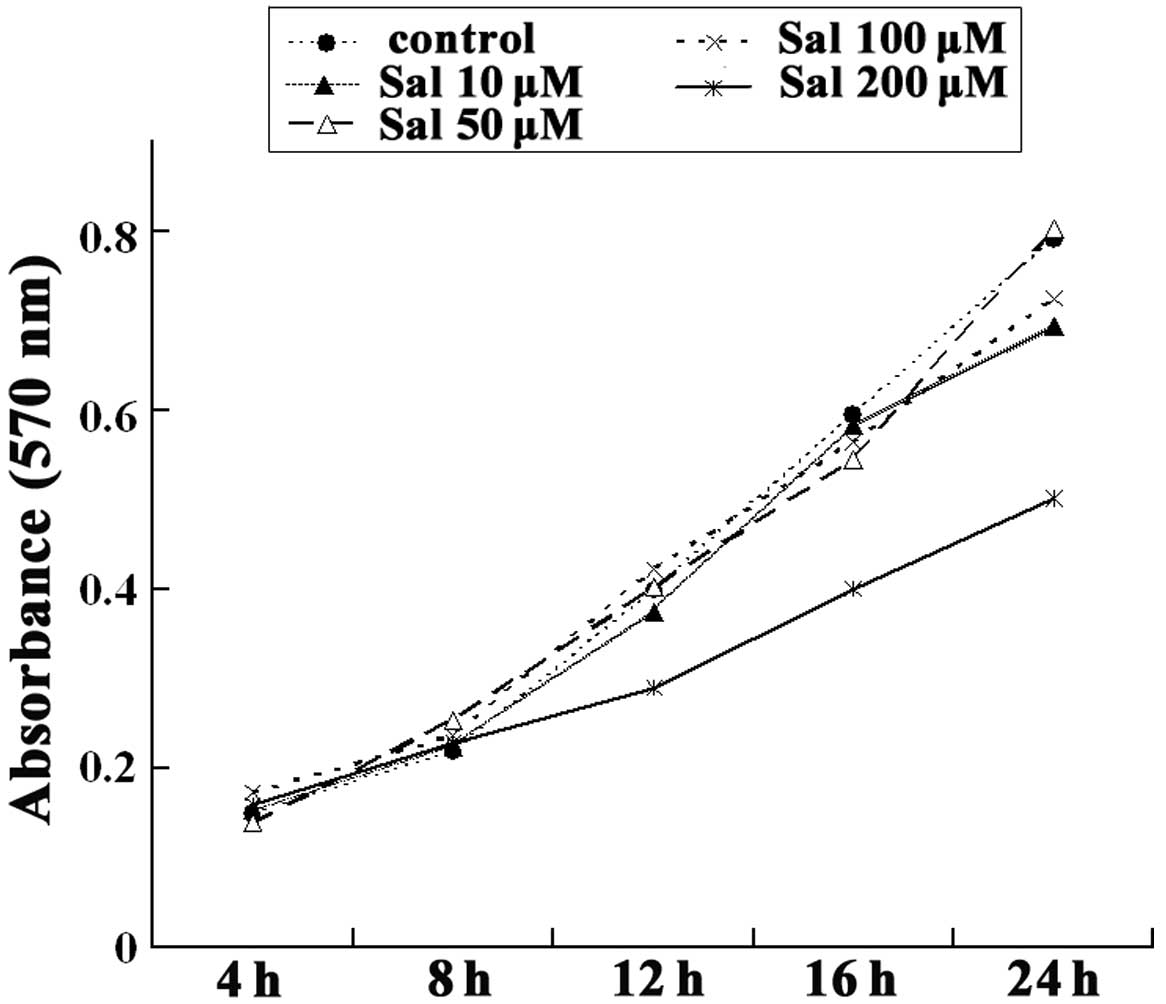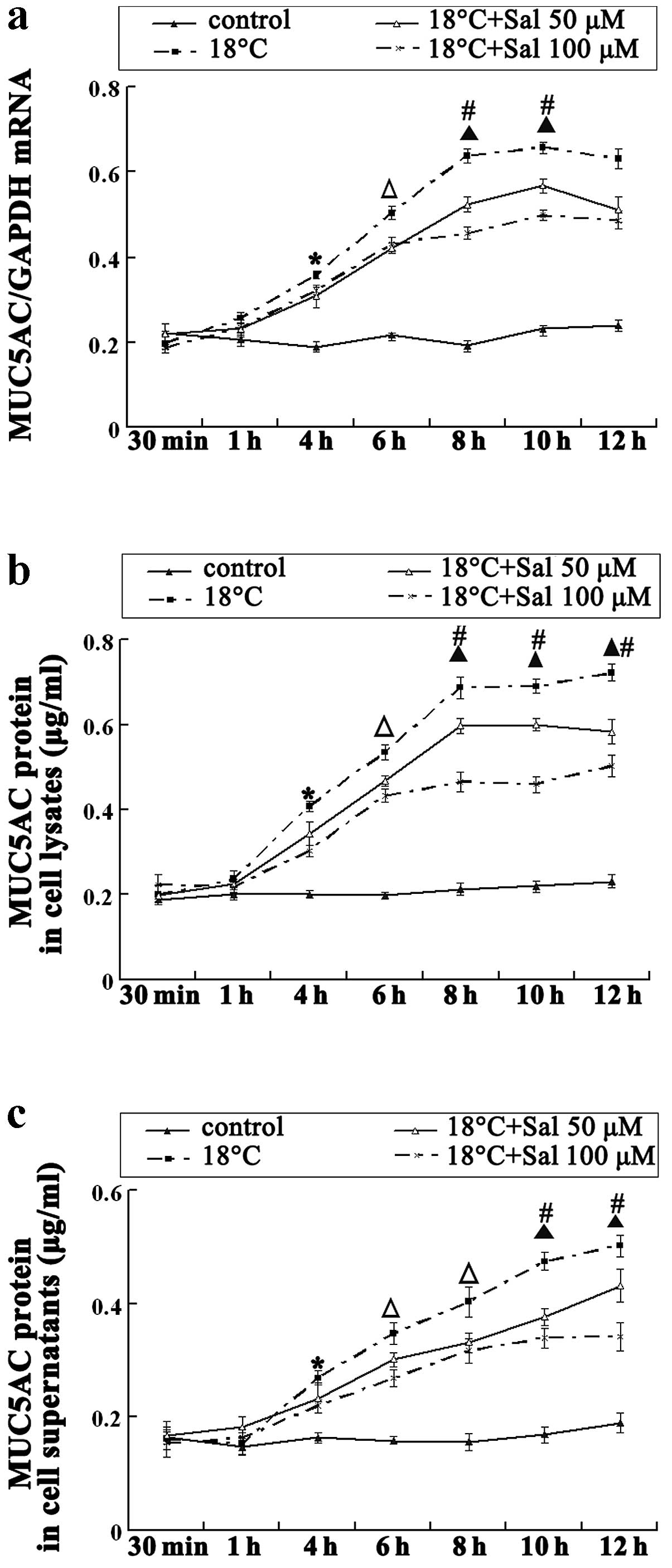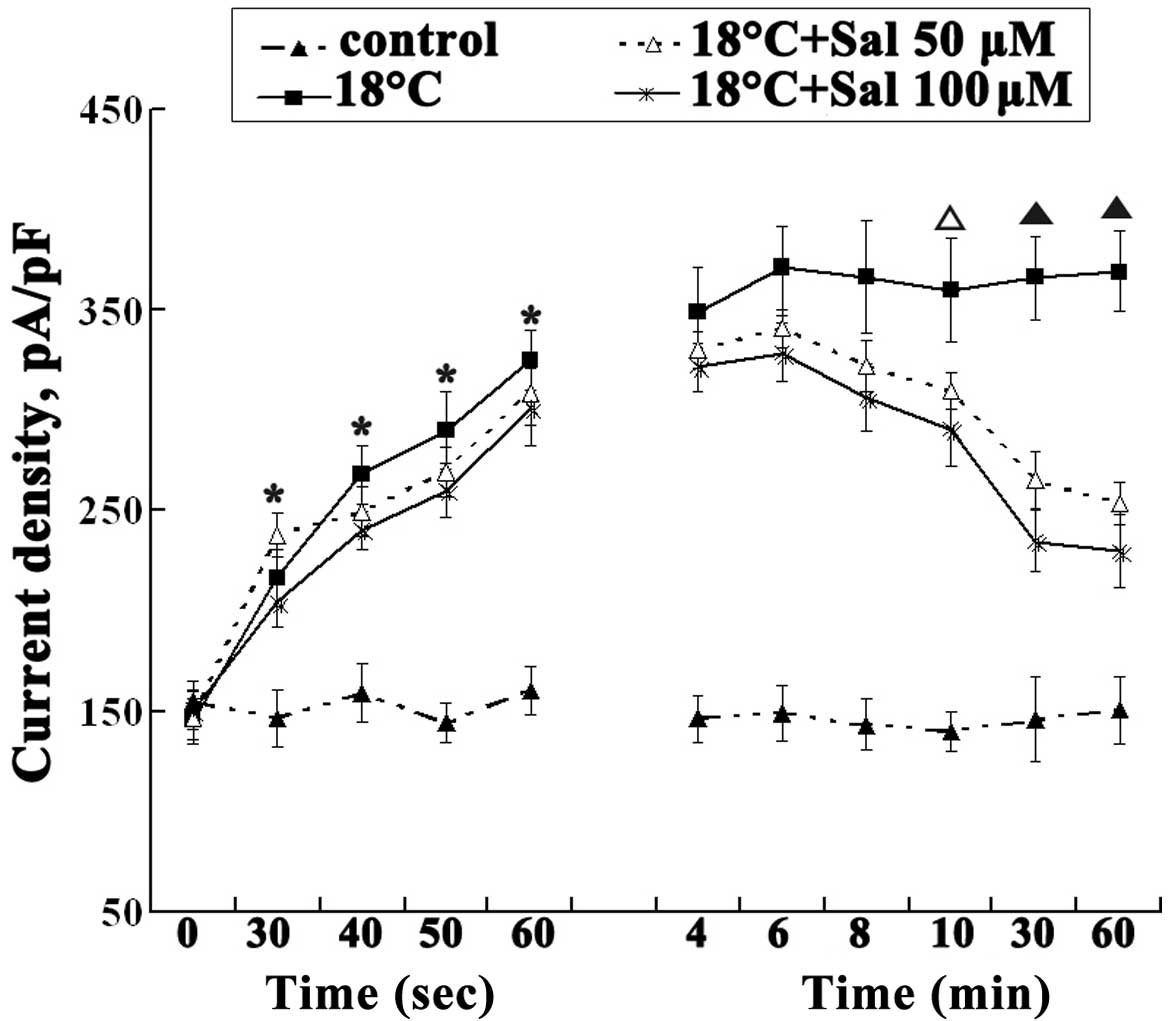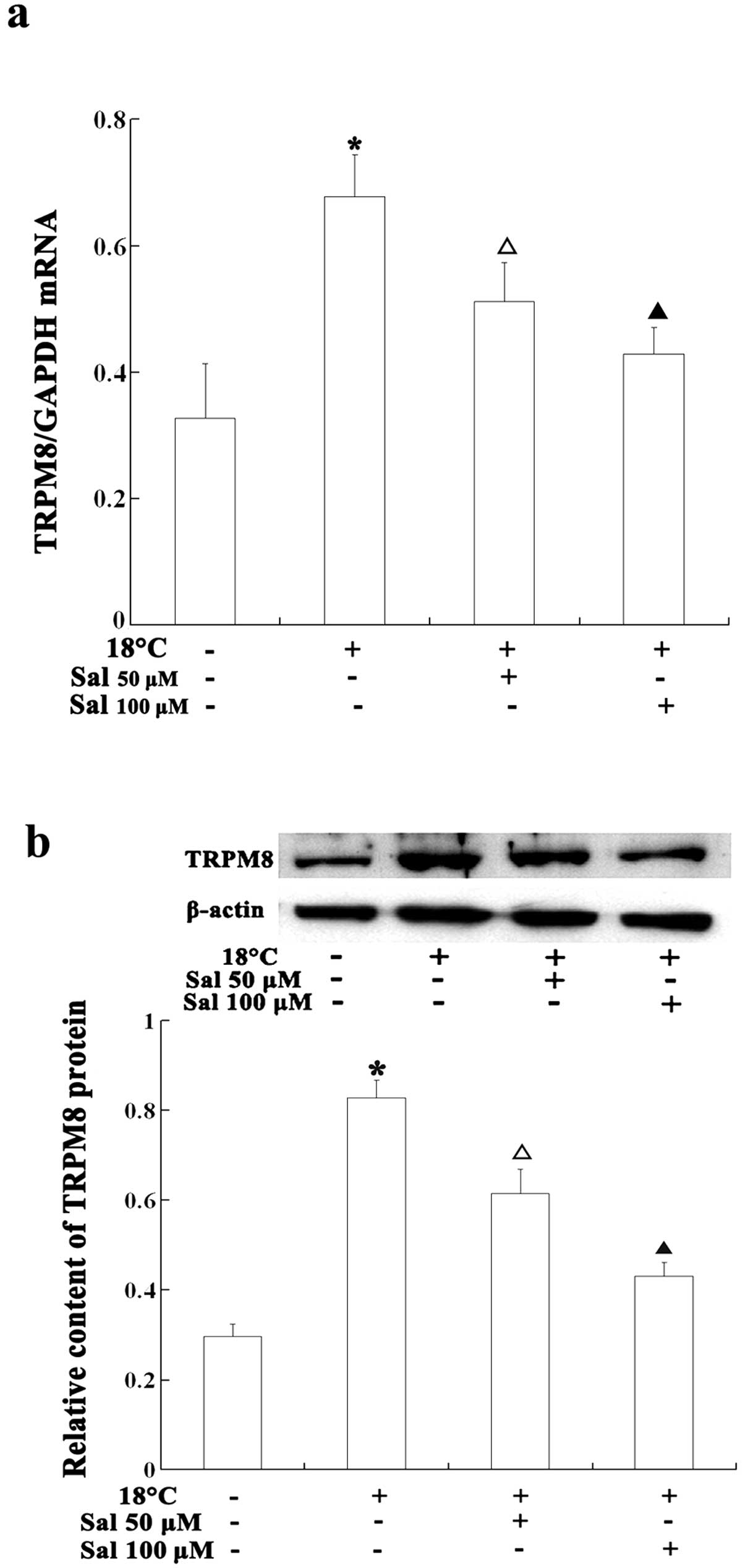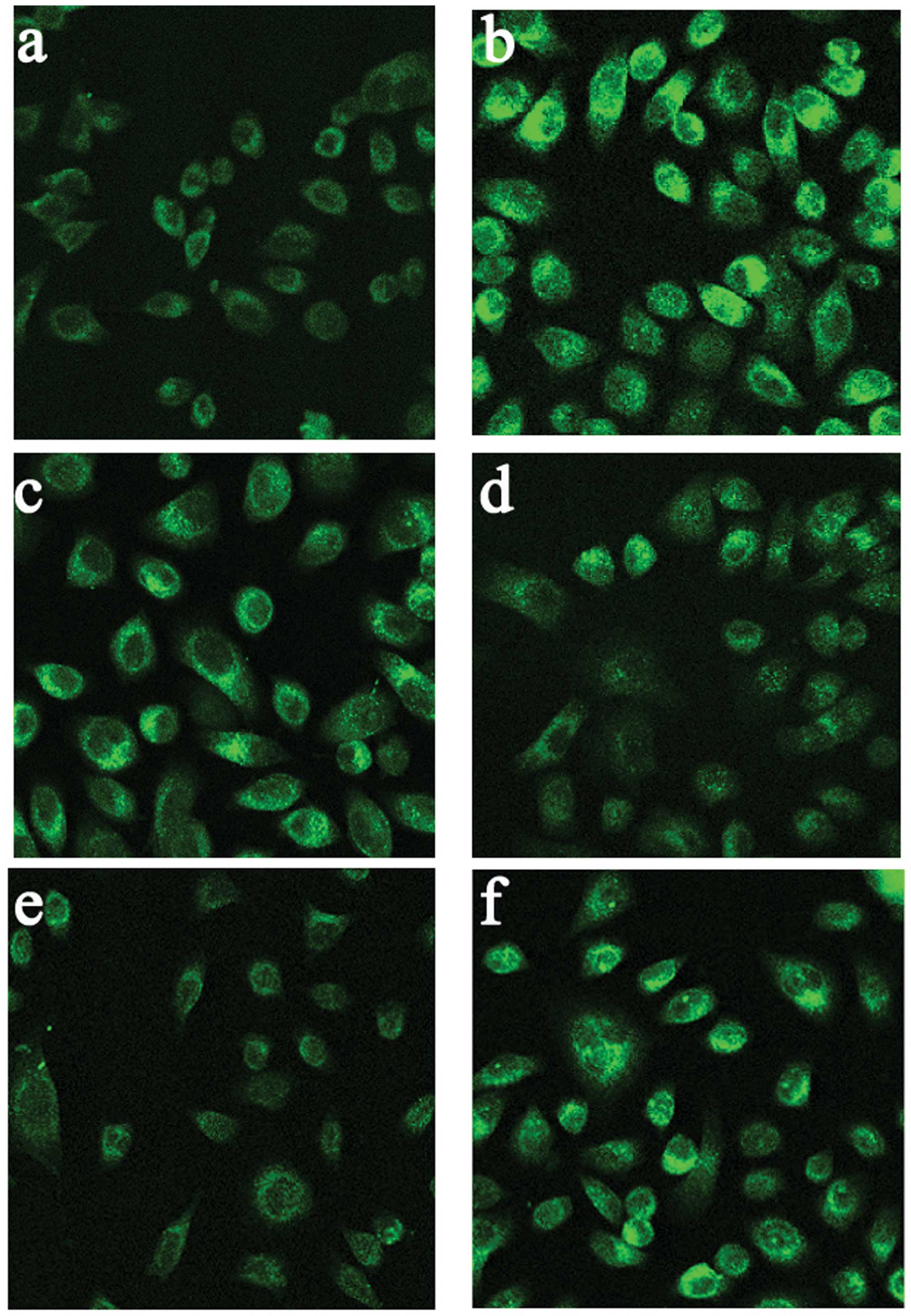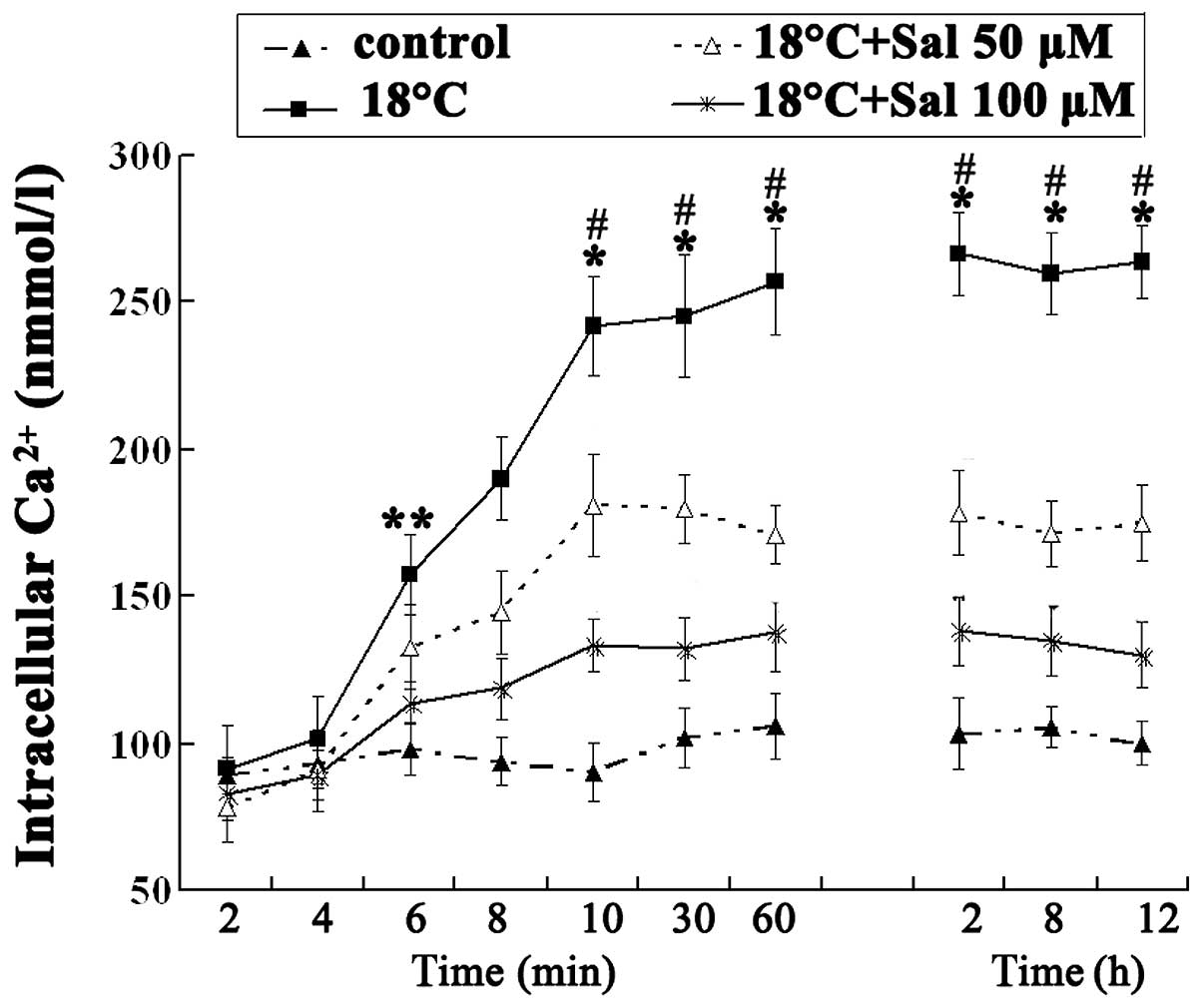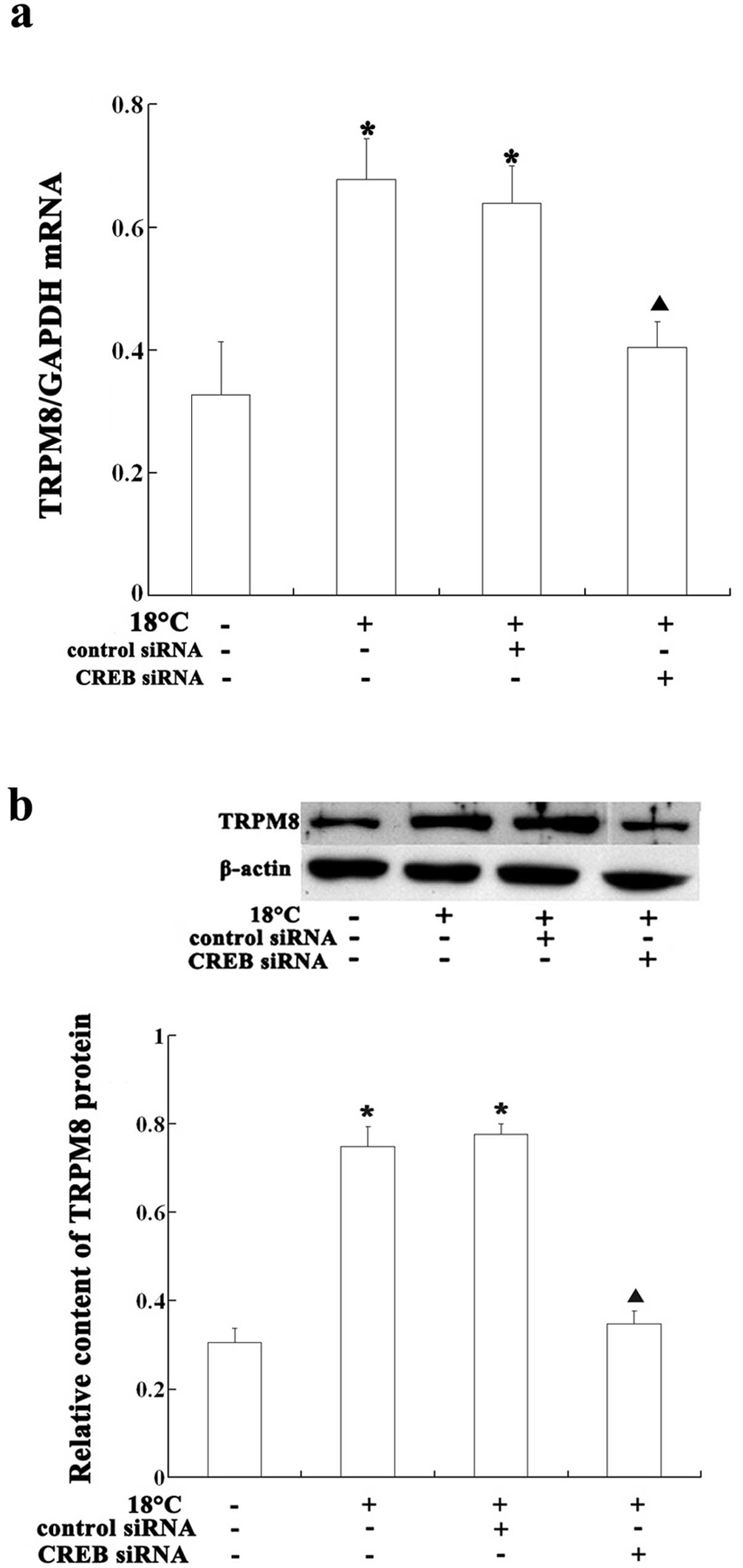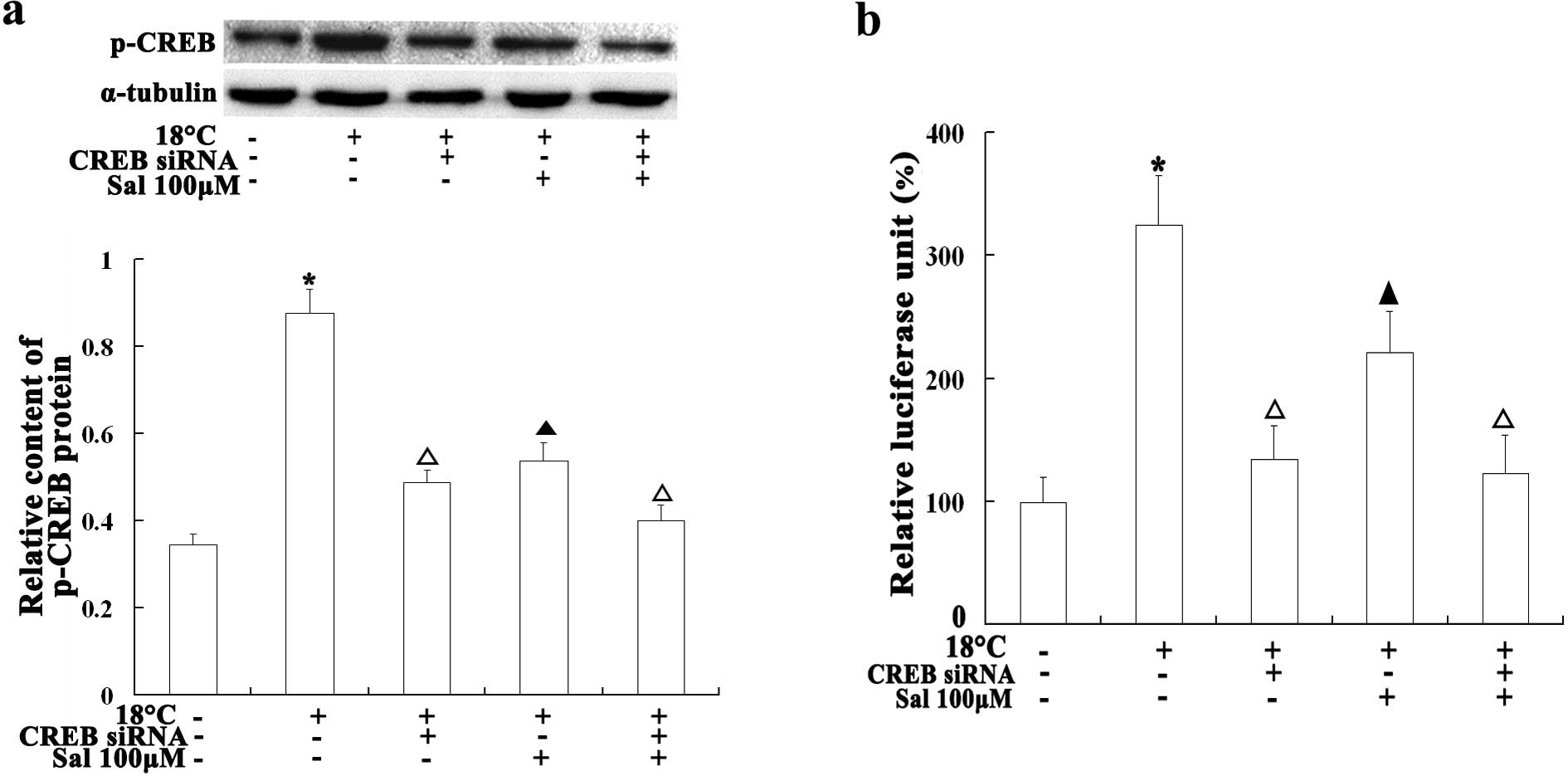Salidroside reduces cold-induced mucin production by inhibiting TRPM8 activation
- Authors:
- Published online on: July 5, 2013 https://doi.org/10.3892/ijmm.2013.1434
- Pages: 637-646
Abstract
Introduction
Cold stimuli are known to exacerbate chronic obstructive pulmonary disease (COPD) and have been shown to promote mucin (MUC) hypersecretion (1). Excessive MUC production leads to airway obstruction and enhances inflammation. Previous studies have mainly focused on secondary inflammatory processes (2) and bacterial (3) or viral infections (4,5) that occur in the airways following exposure to cold temperatures; however, the molecular mechanisms behind cold-induced mucus secretion have not yet been fully elucidated. Human organs express ion channels of the transient receptor potential (TRP) family, including some ion channels that respond at distinct temperature thresholds (6–9). TRP melastatin 8 (TRPM8) is a member of this family that is activated by temperatures ranging from 8 to 25°C. TRPM8 is a ligand-gated cation channel with moderate to high selectivity for calcium ions (10,11).
TRPM8 can be activated by cold temperatures and by cooling agents, such as menthol, eucalyptol and icilin. In a previous study, we found that TRPM8 plays a critical role in cold-induced MUC secretion in the human respiratory system (12). Human airway epithelial cells exposed to cold temperatures exhibited activated TRPM8 channels, and MUC5AC expression was upregulated through the TRPM8-Ca2+-phospholipase C (PLC)-phosphatidylinositol bisphosphate (PIP2) pathway. Thus, we hypothesized that TRPM8 plays a role in cold-induced MUC secretion. In this study, we aimed to discover methods of inhibiting cold-induced MUC hypersecretion.
Salidroside (rhodioside) is a glycoside compound primarily found in the plant, Rhodiola rosea, which grows in cold, high-latitude areas. It is well known that salidroside has pharmacological effects on many pathological conditions, including radiation poisoning (13), inflammation (14), fatigue, aging and hypoxia (15,16). Other studies have found that salidroside exerts its protective effects mainly by repressing the inflow of intracellular free calcium (Ca2+) ([Ca2+]i) into cells. Considering what is already known about salidroside and TRPM8, we hypothesized that salidroside has the ability to protect cells from cold nociceptive stimuli and that it may play a positive role in the airway system. In the present study, we explored the regulation of TRPM8 gene transcription in cold-assaulted cells and examined the effects of salidroside on TRPM8 channels and MUC production. We used the HBE16 human airway epithelial cell line for in vitro studies. The cells were pre-treated with salidroside and exposed to cold temperatures; the protein and mRNA levels of MUC5AC were then determined. The expression levels of TRPM8 and the transcription factor, cAMP response element-binding protein (CREB), were assayed to investigate whether there were any differences in the levels of these factors following treatment with salidroside. Furthermore, we transfected the cells with CREB small interfering RNA (siRNA) to determine whether the transcription factor, CREB, is involved in TRPM8 gene transcription.
Materials and methods
Reagents
Dulbecco's modified Eagle's medium (DMEM)/Ham's F12 medium, HEPES, fetal bovine serum (FBS), anti-β-actin monoclonal antibody, salidroside (>98% purity; National Institute for Food and Drug Control), CREB siRNA and negative control siRNA were purchased from Sigma-Aldrich (St. Louis, MO, USA). Lipofectamine® 2000 and OPTI-MEM Reduced Serum Medium were purchased from Invitrogen (San Diego, CA, USA). The rabbit anti-TRPM8 polyclonal antibody was purchased from Abcam (Cambridge, MA, USA) and the horseradish peroxidase (HRP)-goat anti-rabbit IgG antibody was purchased from Santa Cruz Biotechnology, Inc. (Santa Cruz, CA, USA). CREB-Luc reporter constructs were purchased from Biocat (Catalonia, Spain). The Dual Luciferase Reporter Gene Assay kit was purchased from BioTime Technology (Beijing, China). The pRL-TK Renilla Luciferase Reporter Vector was purchased from Promega (Madison, WI, USA). The high-purity total RNA extraction kit was purchased from Bioteke Biotechnology (Beijing, China). The PrimeScript RT Reagent kit was purchased from Takara (Dalian, China).
Cell culture
HBE16 human airway epithelial cells were plated in 6-well plates at a concentration of 5–6×105 cells/well in 2 ml DMEM/Ham's F12 medium that contained 10% FBS. The cells were then incubated at 37°C and 5% CO2. The culture medium was changed to growth factor-free medium prior to the start of each experiment. Cell supernatants and lysates were collected and assays were performed, as described below.
Cell viability measurements
Confluent HBE16 cells were incubated with 10, 50, 100, or 200 μM salidroside for 24 h. We used the 3-(4,5-dimethylthiazol-2-yl)-2,5-diphenyltetrazolium bromide (MTT) reduction method to detect cell viability and to select the appropriate dose of salidroside for the subsequent experiments.
siRNA transfection
Cells were plated at a density of 1–2×106 cells/ml and incubated at 37°C until the cells were 60–80% confluent. CREB siRNA (0.5 μg) were diluted in 100 μl of siRNA transfection medium (solution A); 6 μl siRNA transfection reagent was diluted in 100 μl of siRNA transfection medium (solution B). The solutions (A + B) were subsequently mixed gently and incubated at room temperature for 45 min. The cells were washed once with 2 ml of siRNA transfection medium followed by the addition of 0.8 ml of the siRNA transfection reagent mixture (solutions A + B). The cells were then incubated for 7 h at 37°C in a CO2 incubator and were recovered in 2 ml of DMEM/Ham's F12 medium containing 10% FBS for an additional 24 h. The medium was then aspirated and replaced with fresh growth medium for the following assays (see below for details).
RNA isolation and real-time PCR for MUC5AC and TRPM8 mRNA
After the HBE16 cells were harvested, total RNA was extracted from the cells using the Bioteke high-purity total RNA extraction kit, and RNA integrity was verified using 1.5% agarose gel electrophoresis. The absorbance at 260/280 nm (A260/280) was in the range of 1.8–2.0. Total RNA was primed with an oligo(dT) primer and reverse transcribed using the PrimeScript RT Reagent kit. Real-time PCR was performed using the SYBR Premix EX Taq™ II real-time PCR kit. The sequences of the primers used for real-time PCR were as follows: MUC5AC (U06711) forward, 5′-CAGCCACGTCCCC TTCAATA-3′ and reverse, 5′-ACCGCATTTGGGCATCC-3′; TRPM8 (NM024080) forward, 5′-ACTCAGAAGGCTGAGG TACA-3′ and reverse, 5′-TTCAGTCGGAGTCTCACTCT-3′; and GAPDH (BC026907) forward, 5′-GAAGGTGAAGGT CGGAGT-3′ and reverse, 5′-GAAGATGGTGATGGGA TTTC-3′. GAPDH was used as the loading control. Relative mRNA expression was determined by comparing it to a standard curve.
Enzyme-linked immunosorbent assay (ELISA) for MUC5AC protein
MUC5AC protein levels in the cell lysates and supernatants were measured using ELISA. Cell lysates at multiple dilutions were prepared with phosphate-buffered saline (PBS). Cell culture supernatants were collected for this assay. In addition, 50 μl of each sample were incubated with bicarbonate-carbonate buffer (50 μl) at 40°C in a 96-well plate until dry. The wells were washed 3 times with PBS and blocked with 2% bovine serum albumin (BSA) for 1 h at room temperature. The wells were then incubated with mouse anti-human MUC5AC monoclonal antibody (45M1) (10 μg/ml; Neomarkers Inc., Fremont, CA, USA) diluted in PBS containing 0.05% Tween-20 for 1 h at room temperature. After washing 3 times, the wells were incubated with HRP-conjugated goat anti-mouse IgG (1 μg/ml) for 1 h. HRP was developed with 3,3′,5,5′-tetramethylbenzidine (TMB) peroxidase solution, quenched with 1 M H2SO4 and the absorbance at 450 nm was measured.
Western blot analysis for TRPM8 and phosphorylated CREB (p-CREB) protein levels
Total protein was determined by BCA analysis. The cells were lysed in lysate buffer, disrupted on ice for 20 min, and then centrifuged at 12,000 rpm for 15 min at 4°C to remove the nuclei and unbroken cells. The total protein concentration in the cell lysates was determined by BCA assay. Equal amounts of protein were diluted in SDS sample buffer and boiled for 5 min. Proteins were resolved on 6% SDS gels. After running, the gels were equilibrated in transfer buffer containing 25 mM Tris-HCl, 192 mM glycine and 20% methanol (pH 8.3). The proteins were then transferred by electrophoresis onto polyvinylidene difluoride (PVDF) membranes. The membranes were incubated in 5% milk dissolved in PBS and 0.05% Tween-20 for 1 h at room temperature and subsequently incubated with rabbit anti-TRPM8 (diluted 1:200) or rabbit anti-p-CREB (Ser-129) polyclonal antibodies (diluted 1:500) overnight at 4°C. After washing 3 times, the membranes were incubated with an HRP-labeled goat anti-rabbit IgG antibody (diluted 1:1,000) for 2 h at room temperature. Enhanced chemiluminescence (ECL) and autoradiography were performed to visualize TRPM8 and p-CREB protein. The membranes were also blotted for β-actin and α-tubulin to ensure equal protein loading.
Immunofluorescence for TRPM8
Cells were fixed with 4% paraformaldehyde and subsequently permeabilized with 0.1% Triton X-100 in PBS for 30 min. The cells were rinsed, blocked in 1% BSA plus 1% normal goat serum and incubated with rabbit anti-TRPM8 (diluted 1:500) overnight at 4°C. After 3 washes of 10 min each in 0.1% Triton X-100/PBS, the cells were incubated with FITC-conjugated fluorescent goat anti-rabbit IgG (1:500) for 2 h at room temperature followed by cellular nuclear staining with 4′6-diamidino-2-phenylindole (DAPI). The samples were examined using a Leica inverted TCS-SP2 confocal microscope that was equipped with appropriate fluorescence filters.
Determination of TRPM8 channel conductivity
Whole-cell patch-clamp experiments were performed using an EPC-10 amplifier and IGOR Pro 4.0 software for data acquisition and analysis. Frequencies of 10 KHz were selected for sampling and 2 KHz for filtration. The extracellular solution used for electrophysiological recordings consisted of 140 mM NaCl, 5 mM KCl, 2 mM CaCl2, 1 mM MgCl2, 0.3 mM Na2HPO4, 0.4 mM KH2PO4, 4 mM NaHCO3, 5 mM glucose and 10 mM HEPES (the pH was adjusted to 7.4 using NaOH). The intracellular solution filled into patch-clamp pipettes contained 140 mM KCl, 1 mM MgCl2, 2.5 mM CaCl2, 4 mM EGTA and 10 mM HEPES. The calculated free Ca2+ concentration in this solution was 150 nM, and the pH was adjusted to 7.2 using KOH as previously described (17). The borosilicate glass patch pipettes used for the whole-cell recordings had resistances of 2–4 MΩ when filled with intracellular solutions.
Ca2+ influx detection
The cells were exposed to cold temperatures (18°C) or pre-treated with salidroside and collected at different time intervals. We resuspended the cells in D-Hanks buffer containing 0.2% FBS (106 cells/ml), removed 1 ml of the cell suspension to an Eppendorf tube and then added 2 μl Fura-2/AM stock solution to the cells followed by incubation with shaking at 37°C for 60 min. The cells were centrifuged at 1,300 rpm for 6 min, washed twice with pre-heated D-Hanks buffer containing 0.2% BSA and resuspended in D-Hanks buffer. The fluorescence intensity was then observed using a dual wavelength spectrophotometer (Hitachi F-3000). The 340/380 nm fluorescence intensity ratio of each sample is abbreviated as R. The 380 nm fluorescence intensity of Fura-2 under CA2+-free and Ca2+ saturation conditions are abbreviated as Fmin and Fmax, respectively. As the controls, 40 μl 2.5% Triton X-100 were added to the cells to detect the maximum fluorescence intensity ratio (Rmax) and 40 μl 250 mM Ca2+ chelator EGTA were added to the cells to detect the minimum fluorescence intensity ratio (Rmin). The [Ca2+]i concentrations were calculated using the formula [Ca2+]i = Kd[(R - Rmin)/(Rmax - R)](Fmin/Fmax).
CREB activity assay
CREB activity was determined using the CREB-Luciferase Reporter Assay System (Biocat). The CREB-Luc and pRL-TK Renilla Luciferase Reporter plasmids were transfected into the HBE16 cells using Lipofectamine® 2000. Eighteen hours after transfection, the cells were pre-incubated with 100 μM salidroside for 30 min and exposed to cold temperatures (18°C). CREB activity was assayed in accordance with the manufacturer's instructions provided with the Luciferase Reporter Gene Assay kit. The results were expressed as detected luciferase relative light units (RLU)/Renilla luciferase RLU.
Statistical analysis
Data analysis was performed using the SPSS 17.0 statistical software package (SPSS, Inc., Chicago, IL, USA). All in vitro experiments using cell lines included samples from at least 6 separate wells and 2–3 independent experiments. Comparisons of >2 groups were made using the Student's t-test or a one-way analysis of variance (ANOVA) followed by Bonferroni's analysis. A P-value <0.05 was considered to indicate a statistically significant difference.
Results
Viability of HBE16 cells following exposure to salidroside
The cells were incubated with 10, 50, 100, or 200 μM salidroside for various periods of time to determine cellular proliferation rates following exposure to salidroside. Salidroside at a concentration of 200 μM inhibited cell proliferation after 16 h. Following incubation with 10, 50, or 100 μM salidroside for 24 h, the viability of these cells did not differ significantly from that of the non-treated cells (Fig. 1). These results indicate that lower doses of salidroside do not affect cell viability. Therefore, we selected to use the concentrations of 50 and 100 μM for the following experiments.
Salidroside decreases cold-induced MUC5AC expression
To investigate the effects of cold temperatures on MUC5AC expression in airway epithelial cells, we exposed the HBE16 cells to cold temperatures (18°C) for various periods of time. MUC5AC mRNA levels were upregulated after 1 h of exposure to cold temperatures, with the concentration of MUC5AC protein in the cell lysates and culture supernatants increasing as well. The mRNA and protein levels of MUC5AC continued to increase, reaching a plateau at 8 h. These results indicate that exposure to cold temperatures actively induces MUC5AC expression. The cells were then incubated with 50 μM salidroside prior to exposure cold temperatures. The MUC5AC protein and mRNA levels in the salidroside-treated cells were lower than those observed in the cold-stimulated group at 6 h. Treatment of the cells with 100 μM salidroside for 8 h significantly attenuated the cold-induced intracellular synthesis and secretion of the MUC5AC protein (Fig. 2), indicating that salidroside time- and dose-dependently reduced MUC5AC expression induced by cold stimulation.
Salidroside decreases ITRPM8 membrane currents
In a previous study, we found that cold temperatures induce TRPM8 activation (12). We further assayed the activation of TRPM8 in cold-stimulated HBE16 cells by patch-clamping the cells at various time points following exposrue to cold temperatures. The current density of cold-stimulated TRPM8 channels increased at 15 sec and reached a plateau at 6 min. In the salidroside-treated cells, TRPM8 activation began to decrease after 40 sec. Salidroside significantly decreased the current through cold-stimulated TRPM8 channels at 10 min of recording in comparison with the untreated cold-stimulated channels (P<0.05). The 100 μM concentration of salidroside was more effective at reducing currents than the 50 μM concentration, showing maximal effects at 20 min (Fig. 3). These results indicate that TRPM8 activation is involved in cold-stimulated MUC expression and that salidroside inhibits currents through TRPM8, suggesting a previously unknown property of salidroside.
Salidroside reduces cold-induced TRPM8 expression in HBE16 cells
To further confirm the inhibitory effects of salidroside on TRPM8, we investigated the mRNA and protein expression of TRPM8 following incubation with salidroside. The cells were pre-treated with salidroside and then exposed to cold temperatures (18°C). The TRPM8 mRNA and protein levels were then detected by real-time PCR, western blot analysis and immunofluorescence assay, respectively. The cells were exposed to cold temperatures (18°C) for 6 h; exposure to cold temperatures significantly increased TRPM8 protein and mRNA levels compared with the normal control group (P<0.05), and the cellular TRPM8 levels continued to increase in a time-dependent manner. The cells pre-treated with salidroside prior to exposure to cold temperatures had lower TRPM8 expression levels than the non-treated cells (P<0.05). The high dose of salidroside (100 μM) showed more potent inhibitory effects on increased TRPM8 expression than the low dose (50 μM) (Figs. 4 and 5). These results indicate that salidroside represses TRPM8 not only by reducing TRPM8 activation but also by inhibiting TRPM8 mRNA and protein expression.
Salidroside inhibits [Ca2+]i in HBE16 cells
To investigate the mechanisms underlying the salidroside-mediated TRPM8 inhibition, we assayed the free calcium influx in the cells, which is crucial to TRPM8 activation and is known to play a role in many other salidroside-mediated protective events. The HBE16 cells were loaded with Fura-2/AM to examine the intracellular calcium concentration. When the HBE16 cells were exposed to cold temperatures (18°C), we observed that the [Ca2+]i concentration began to increase after 4 min and continued to increase, reaching a plateau at 10 min, compared with the normal group (P<0.01). In the HBE16 cells incubated with salidroside prior to exposure to cold temperatures, the increase in the [Ca2+]i concentration was significantly attenuated at 8 min. Furthermore, pre-treatment of the cells with both concentrations of salidroside (50 and 100 μM) decreased the [Ca2+]i concentration in a dose-dependent manner (Fig. 6).
Salidroside decreases TRPM8 expression by inhibiting CREB activity in HBE16 cells
Previous studies have reported that the TRPM8 promoter may have a CREB binding site (18). To determine whether CREB is involved in TRPM8 activation, we first assayed the expression and activity of CREB in the cells under cold assault, and then transfected the cells with CREB siRNA to investigate the effects of CREB on TRPM8 expression. Following the incubation of the HBE16 cells under cold conditions for 6 h, the mRNA and protein levels of TRPM8 increased when compared with the control cells kept at warm temperatures. When the cells were transfected with CREB siRNA prior to exposure to cold temperatures (18°C), the TRPM8 mRNA and protein levels were considerably lower than the levels observed in the non-transfected cells (Figs. 5 and 7). Exposure to cold temperatures also increased the levels of p-CREB. The cells transfected with CREB siRNA showed lower levels of p-CREB, an effect similar to the one observed in the salidroside-treated cells (P<0.05 compared with the cold-stimulated (18°C) cells (Fig. 8A). We additionally transfected the cells with a CREB-Luc Reporter plasmid to measure the activity of CREB in the cold-stimulated cells. The cells exposed to cold temperatures (18°C) showed higher RLU levels than the normal control cells, while the cells incubated with salidroside prior to exposure to cold temperatures exhibited lower RLU levels than the cold-stimulated cells not treated with salidroside (P<0.01) (Fig. 8B). These results suggest that CREB plays an important role in TRPM8 gene transcription and that salidroside represses TRPM8 expression by inhibiting CREB activity.
Discussion
Mucus overproduction is a clinical hallmark of acute exacerbation of COPD. One of the important aggravating factors is exposure to cold temperatures, which can cause mucociliary dysfunction and the accumulation of inflammatory factors, which may ultimately result in a bacterial infection in the respiratory system. The effective management of COPD exacerbation requires a thorough understanding of the underlying pathophysiological mechanisms that shape its clinical manifestation. In a previous study, we reported that cold temperatures induce MUC hypersecretion in human airway epithelial cells through a TRPM8-mediated mechanism (12). TRPM8 is a major cold receptor in the body with variants that are expressed by the human respiratory system (19). TRPM8 is activated by temperatures between 8 and 25°C (20) and is a member of the TRP family of Ca2+-permeable, non-selective cation channels and the TRPM subfamily of TRP proteins (21–23). We found that TRPM8 is highly expressed in human airway epithelial cells following exposure to cold stimuli. Functional assays revealed that TRPM8 activation significantly reduced MUC secretion induced by cold temperatures; however, the intervention mechanims for TRPM8-related events have not yet been fully elucidated.
Rhodiola rosea has long been used in traditional Chinese medicine and it primarily grows at high altitude in thin air and cold weather conditions. Salidroside is the major active ingredient isolated from the plant, Rhodiola rosea, and possesses the ability to enhance the resistance of the body to fatigue and cold (24). Salidroside has also been reported to have potent antioxidant and anti-aging properties (25). Salidroside has been shown to reduce H2O2-induced cell apoptosis in SH-SY5Y human neuroblastoma cells (26,27). However, the potential effects of salidroside on cold-induced airway inflammation have not yet been fully elucidated. The respiratory epithelium communicates directly with the external environment. When cold air is inhaled, the respiratory tract loses a considerable amount of heat. This heat loss may be followed by a series of stress reactions. Cold air-induced respiratory symptoms include MUC oversecretion and inflammation, and these phenomena are common in countries or areas with a cold climate (28). It has also been reported that people living at high latitudes exhibit perturbed mucociliary function, placing them at a higher risk of developing nasal obstruction and cough (29). Considering the known properties of salidroside, we hypothesized that it may play a role in regulating homeostasis in the airway system.
In this study, we found that HBE16 cells exposed to cold temperatures exhibited a marked increase in MUC5AC levels and TRPM8 activation. By contrast, cells pre-treated with various concentrations of salidroside (10, 50 and 100 μM) prior to the cold assault exhibited a dose- and time-dependent decrease in MUC5AC expression, indicating that salidroside is capable of protecting HBE16 cells from cold-induced MUC oversecretion. Furthermore, we found that the [Ca2+]i concentration rapidly and robustly increased in the cold-stimulated cells, reaching a plateau at 6 to 10 min following exposure to cold temperatures. The cells pre-treated with salidroside showed decreased levels of [Ca2+]i and TRPM8 activation, with the [Ca2+]i concentration decreasing as early as 1 min following incubation with salidroside and reaching a minimal level at 2 h post-treatment. High doses of salidroside inhibited the inflow of Ca2+ almost completely.
[Ca2+]i is an important second messenger in various types of cells, regulating functional and physiological cellular activities, such as contraction, secretion, signal transmission and transcriptional regulation. Under normal circumstances, the extracellular concentration of calcium is usually 0.1–10 mM and the intracellular calcium concentration is 10−7–10−8 M, much lower than the calcium concentrations in the extracellular environment. Ca2+-dependent cellular signaling pathways are activated by alterations in the levels of [Ca2+]i. When cells are exposed to stimuli such as inflammation (30), hypoxia (31) and cold temperatures (32), there is an influx of extracellular calcium or a release of calcium from the cellular endoplasmic reticulum, either of which overloads the [Ca2+]i level. The [Ca2+]i concentration plays an important role in the activation of TRPM8. Studies have also shown that TRPM8 mediates transmembrane Ca2+ flux (33). However, the excessive inflow of Ca2+ leads to desensitization of TRPM8, a process that is mediated through the Ca2+-dependent activation of protein kinase C (PKC) (34,35). TRPM8 is also regulated by a number of kinases and second messengers, such as PLC, PIP2 (36,37), phospholipase A2 (PLA2), lysophospholipids (LPLs) (38,39), arachidonic acid (AA) (40) and cAMP (41).
CREB is a 43-kDa leucine zipper transcription factor that belongs to the activating transcription factor (ATF) subfamily of the basic-region leucine zipper (bZIP) family. CREB primarily responds to the cAMP signaling pathway, binding to CREs to increase or decrease the transcription of certain genes (42). CREB-mediated transcription regulates various cellular responses, including intermediary metabolism, neuronal signaling, cell proliferation, apoptosis and other molecular events. The CREB protein contains an N-terminal transaction domain (kinase-induced domain), a basic region and a leucine zipper motif at the C-terminus. The transaction domain includes a phosphorylation site at Ser133 that is recognized by certain protein kinases (43). CREB can be activated by a variety of stimuli, including peptide hormones, growth factors, forskolin, phorbol esters and a number of protein kinases, including protein kinase A (PKA), pp90 ribosomal S6 kinase (pp90RSK), and Ca2+/calmodulin-dependent protein kinases (CaMKs) (44,45).
It has been reported that the TRPM8 core promoter region contains a CRE, which is possibly located between base pairs −1,417 and −1,406. It may play an important role in promoting the transcription of TRPM8 (18,46). Therefore, we further examine whether the transcription factor, CREB, is involved in TRPM8 expression. We found that the expression of p-CREB protein and CREB activity were significantly elevated in the cells exposed to cold temperatures compared with the control cells. CREB phosphorylation and activity levels were lower in the cells pre-treated with salidroside than the untreated cells. While TRPM8 expression decreased in the cells transfected with CREB siRNA, the expression of TRPM8 in the cells transfected with CREB siRNA and incubated with salidroside prior to exposure to cold temperatures decreased even more significantly. These results indicate not only that CREB activation directly contributes to TRPM8 expression, but also that salidroside inhibits TRPM8 expression by decreasing the activation and activity of CREB.
The known chemical antagonists of TRPM8 are capsazepine, N-(4-tert-butylphenyl)-4-(3-chloropyridin-2-yl)tetrahydropyrazine-1(2H)-carboxamite (BCTC) and thiol BCTC. While these are all synthesized chemicals, salidroside is a component of the Chinese herb, Rhodiola rosea, which may be a natural candidate for the treatment of diseases involving TRPM8 overexpression. The regulation of TRPM8 expression by salidroside is important for the identification of alternative treatment modalities for airway mucus hypersecretory diseases induced by cold stimuli.
Acknowledgements
The present study was supported by the National Nature Science Foundation of China (grant no. 81100003 and 31171346), and the China-Russia Cooperation Research Foundation (grant no. 31211120168), and the New Teacher Fund for Doctor Station, the Ministry of Education, China (no. 20115503120006), and Chongqing Nature Science Foundation (grant no. cstc2011jjA10046).
References
|
Giesbrecht GG: The respiratory system in a cold environment. Aviat Space Environ Med. 66:890–902. 1995.PubMed/NCBI | |
|
Voynow JA and Rubin BK: Mucins, mucus, and sputum. Chest. 135:505–512. 2009. View Article : Google Scholar : PubMed/NCBI | |
|
Zhen G, Park SW, Nguyenvu LT, Rodriguez MW, Barbeau R, Paquet AC and Erle DJ: IL-13 and epidermal growth factor receptor have critical but distinct roles in epithelial cell mucin production. Am J Respir Cell Mol Biol. 36:244–253. 2007. View Article : Google Scholar : PubMed/NCBI | |
|
Zhu L, Lee PK, Lee WM, Zhao Y, Yu D and Chen Y: Rhinovirus-induced major airway mucin production involves a novel TLR3-EGFR-dependent pathway. Am J Respir Cell Mol Biol. 40:610–619. 2009. View Article : Google Scholar : PubMed/NCBI | |
|
Turner J and Jones CE: Regulation of mucin expression in respiratory diseases. Biochem Soc Trans. 37:877–881. 2009. View Article : Google Scholar | |
|
Caterina MJ, Leffler A, Malmberg AB, Martin WJ, Trafton J, Petersen-Zeitz KR, Koltzenburg M, Basbaum AI and Julius D: Impaired nociception and pain sensation in mice lacking the capsaicin receptor. Science. 288:306–313. 2000. View Article : Google Scholar : PubMed/NCBI | |
|
Caterina MJ, Rosen TA, Tominaga M, Brake AJ and Julius D: A capsaicin-receptor homologue with a high threshold for noxious heat. Nature. 398:436–441. 1999. View Article : Google Scholar : PubMed/NCBI | |
|
Smith GD, Gunthorpe MJ, Kelsell RE, Hayes PD, Reilly P, Facer P, Wright JE, Jerman JC, Walhin JP, Ooi L, Egerton J, Charles KJ, Smart D, Randall AD, Anand P and Davis JB: TRPV3 is a temperature-sensitive vanilloid receptor-like protein. Nature. 418:186–190. 2002. View Article : Google Scholar : PubMed/NCBI | |
|
Güler AD, Lee H, Iida T, Shimizu I, Tominaga M and Caterina M: Heat-evoked activation of the ion channel, TRPV4. J Neurosci. 2:6408–6414. 2002.PubMed/NCBI | |
|
McKemy DD, Neuhausser WM and Julius D: Identification of a cold receptor reveals a general role for TRP channels in thermosensation. Nature. 416:52–58. 2002. View Article : Google Scholar : PubMed/NCBI | |
|
Peier AM, Moqrich A, Hergarden AC, Reeve AJ, Andersson DA, Story GM, Earley TJ, Dragoni I, McIntyre P, Bevan S and Patapoutian A: A TRP channel that senses cold stimuli and menthol. Cell. 108:705–715. 2002. View Article : Google Scholar : PubMed/NCBI | |
|
Li MC, Li Q, Yang G, Kolosov VP, Perelman JM and Zhou XD: Cold temperature induces mucin hypersecretion from normal human bronchial epithelial cells in vitro through a transient receptor potential melastatin 8 (TRPM8)-mediated mechanism. J Allergy Clin Immunol. 128:626–634. 2011. View Article : Google Scholar | |
|
Li YR, Cao W, Guo J, Miao S, Ding GR, Li KC, Wang J and Guo GZ: Comparative investigations on the protective effects of rhodioside, ciwujianoside-B and astragaloside IV on radiation injuries of the hematopoietic system in mice. Phytother Res. 25:644–653. 2011.PubMed/NCBI | |
|
Díaz Lanza AM, Abad Martínez MJ, Fernández Matellano L, Recuero Carretero C, Villaescusa Castillo L, Silván Sen AM and Bermejo Benito P: Lignan and phenylpropanoid glycosides from Phillyrea latifolia and their in vitro anti inflammatory activity. Planta Med. 67:219–223. 2001. | |
|
Kelly GS: Rhodiola rosea: a possible plant adaptogen. Altern Med Rev. 6:293–302. 2001. | |
|
Kucinskaite A, Briedis V and Savickas A: Experimental analysis of therapeutic properties of Rhodiola rosea L. and its possible application in medicine. Medicina (Kaunas). 40:614–619. 2004.(In Lithuanian). | |
|
Bavencoffe A, Kondratskyi A, Gkika D, Mauroy B, Shuba Y, Prevarskaya N and Skryma R: Complex regulation of the TRPM8 cold receptor channel: role of arachidonic acid release following M3 muscarinic receptor stimulation. J Biol Chem. 286:9849–9855. 2011. View Article : Google Scholar : PubMed/NCBI | |
|
Bidaux G, Roudbaraki M, Merle C, Crépin A, Delcourt P, Slomianny C, Thebault S, Bonnal JL, Benahmed M, Cabon F, Mauroy B and Prevarskaya N: Evidence for specific TRPM8 expression in human prostate secretory epithelial cells: functional androgen receptor requirement. Endocr Relat Cancer. 12:367–382. 2005. View Article : Google Scholar : PubMed/NCBI | |
|
Sabnis AS, Shadid M, Yost GS and Reilly CA: Human lung epithelial cells express a functional cold-sensing TRPM8 variant. Am J Respir Cell Mol Biol. 39:466–474. 2008. View Article : Google Scholar : PubMed/NCBI | |
|
McCoy DD, Knowlton WM and McKemy DD: Scraping through the ice: uncovering the role of TRPM8 in cold transduction. Am J Physiol Regul Integr Comp Physiol. 300:R1278–R1287. 2011. View Article : Google Scholar : PubMed/NCBI | |
|
Zhang L and Barritt GJ: TRPM8 in prostate cancer cells: a potential diagnostic and prognostic marker with a secretory function? Endocr Relat Cancer. 13:27–38. 2006. View Article : Google Scholar : PubMed/NCBI | |
|
Behrendt HJ, Germann T, Gillen C, Hatt H and Jostock R: Characterization of the mouse cold-menthol receptor TRPM8 and vanilloid receptor type-1 VR1 using a fluorometric imaging plate reader (FLIPR) assay. Br J Pharmacol. 141:737–745. 2004. View Article : Google Scholar : PubMed/NCBI | |
|
Andersson DA, Chase HW and Bevan S: TRPM8 activation by menthol, icilin, and cold is differentially modulated by intracellular pH. J Neurosci. 24:5364–5369. 2004. View Article : Google Scholar : PubMed/NCBI | |
|
Tolonen A, Pakonen M, Hohtola A and Jalonen J: Phenylpropanoid glycosides from Rhodiola rosea. Chem Pharm Bull (Tokyo). 51:467–470. 2003. View Article : Google Scholar | |
|
Mao GX, Wang Y, Qiu Q, Deng HB, Yuan LG, Li RG, Song DQ, Li YY, Li DD and Wang Z: Salidroside protects human fibroblast cells from premature senescence induced by H(2)O(2) partly through modulating oxidative status. Mech Ageing Dev. 131:723–731. 2010. View Article : Google Scholar | |
|
Li X, Ye X, Li X, Sun X, Liang Q, Tao L, Kang X and Chen J: Salidroside protects against MPP(+)-induced apoptosis in PC12 cells by inhibiting the NO pathway. Brain Res. 1382:9–18. 2011. | |
|
Zhang L, Yu H, Sun Y, Lin X, Chen B, Tan C, Cao G and Wang Z: Protective effects of salidroside on hydrogen peroxide-induced apoptosis in SH-SY5Y human neuroblastoma cells. Eur J Pharmacol. 564:18–25. 2007. View Article : Google Scholar : PubMed/NCBI | |
|
Koskela HO: Cold air-provoked respiratory symptoms: the mechanisms and management. Int J Circumpolar Health. 66:91–100. 2007. View Article : Google Scholar : PubMed/NCBI | |
|
Rodway GW and Windsor JS: Airway mucociliary function at high altitude. Wilderness Environ Med. 17:271–275. 2006. View Article : Google Scholar : PubMed/NCBI | |
|
Dada LA and Sznajder JI: Mitochondrial Ca2+ and ROS take center stage to orchestrate TNF-α-mediated inflammatory responses. J Clin Invest. 121:1683–1685. 2011.PubMed/NCBI | |
|
Gusarova GA, Trejo HE, Dada LA, Briva A, Welch LC, Hamanaka RB, Mutlu GM, Chandel NS, Prakriya M and Sznajder JI: Hypoxia leads to Na,K-ATPase downregulation via Ca(2+) release-activated Ca(2+) channels and AMPK activation. Mol Cell Biol. 31:3546–3556. 2011.PubMed/NCBI | |
|
Galli GL, Lipnick MS, Shiels HA and Block BA: Temperature effects on Ca2+ cycling in scombrid cardiomyocytes: a phylogenetic comparison. J Exp Biol. 214:1068–1076. 2011.PubMed/NCBI | |
|
Cho Y, Jang Y, Yang YD, Lee CH, Lee Y and Oh U: TRPM8 mediates cold and menthol allergies associated with mast cell activation. Cell Calcium. 48:202–208. 2010. View Article : Google Scholar : PubMed/NCBI | |
|
Abe J, Hosokawa H, Sawada Y, Matsumura K and Kobayashi S: Ca2+-dependent PKC activation mediates menthol-induced desensitization of transient receptor potential M8. Neurosci Lett. 397:140–144. 2006. | |
|
Premkumar LS, Raisinghani M, Pingle SC, Long C and Pimentel F: Downregulation of transient receptor potential melastatin 8 by protein kinase C-mediated dephosphorylation. J Neurosci. 25:11322–11329. 2005. View Article : Google Scholar : PubMed/NCBI | |
|
Daniels RL, Takashima Y and McKemy DD: Activity of the neuronal cold sensor TRPM8 is regulated by phospholipase C via the phospholipid phosphoinositol 4,5-bisphosphate. J Biol Chem. 84:1570–1582. 2009.PubMed/NCBI | |
|
Rohács T, Lopes CM, Michailidis I and Logothetis DE: PI(4,5)P2 regulates the activation and desensitization of TRPM8 channels through the TRP domain. Nat Neurosci. 8:626–634. 2005. | |
|
Andersson DA, Nash M and Bevan S: Modulation of the cold-activated channel TRPM8 by lysophospholipids and polyunsaturated fatty acids. J Neurosci. 27:3347–3355. 2007. View Article : Google Scholar : PubMed/NCBI | |
|
Vanden Abeele F, Zholos A, Bidaux G, Shuba Y, Thebault S, Beck B, Flourakis M, Panchin Y, Skryma R and Prevarskaya N: Ca2+-independent phospholipase A2-dependent gating of TRPM8 by lysophospholipids. J Biol Chem. 281:40174–40182. 2006. | |
|
Bavencoffe A, Gkika D, Kondratskyi A, Beck B, Borowiec AS, Bidaux G, Busserolles J, Eschalier A, Shuba Y, Skryma R and Prevarskaya N: The transient receptor potential channel TRPM8 is inhibited via the alpha 2A adrenoreceptor signaling pathway. J Biol Chem. 285:9410–9419. 2010. View Article : Google Scholar : PubMed/NCBI | |
|
De Petrocellis L, Starowicz K, Moriello AS, Vivese M, Orlando P and Di Marzo V: Regulation of transient receptor potential channels of melastatin type 8 (TRPM8): effect of cAMP, cannabinoid CB(1) receptors and endovanilloids. Exp Cell Res. 313:1911–1920. 2007.PubMed/NCBI | |
|
Andrisani OM: CREB-mediated transcriptional control. Crit Rev Eukaryot Gene Expr. 9:19–32. 1999. | |
|
Johannessen M and Moens U: Multisite phosphorylation of the cAMP response element-binding protein (CREB) by a diversity of protein kinases. Front Biosci. 12:1814–1832. 2007.PubMed/NCBI | |
|
Johannessen M, Delghandi MP, Seternes OM, Johansen B and Moens U: Synergistic activation of CREB-mediated transcription by forskolin and phorbol ester requires PKC and depends on the glutamine-rich Q2 transactivation domain. Cell Signal. 16:1187–1199. 2004. View Article : Google Scholar | |
|
Shaywitz AJ and Greenberg ME: CREB: a stimulus-induced transcription factor activated by a diverse array of extracellular signals. Annu Rev Biochem. 68:821–861. 1999. View Article : Google Scholar : PubMed/NCBI | |
|
Zhang L and Barritt GJ: Evidence that TRPM8 is an androgen-dependent Ca2+ channel required for the survival of prostate cancer cells. Cancer Res. 64:8365–8373. 2004. View Article : Google Scholar : PubMed/NCBI |



